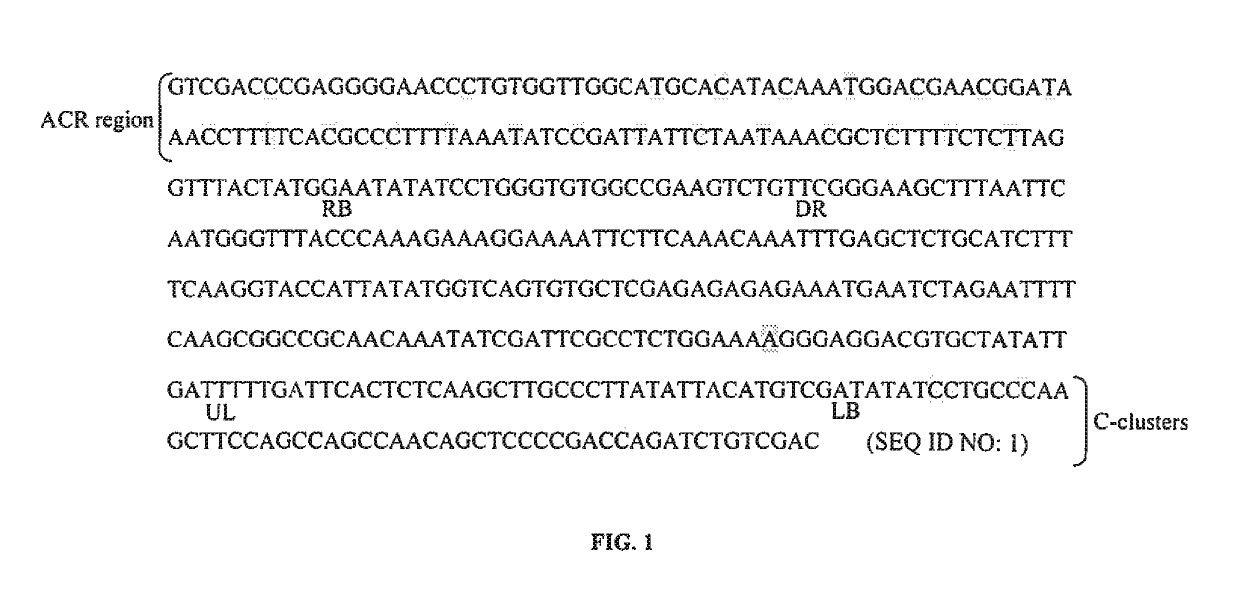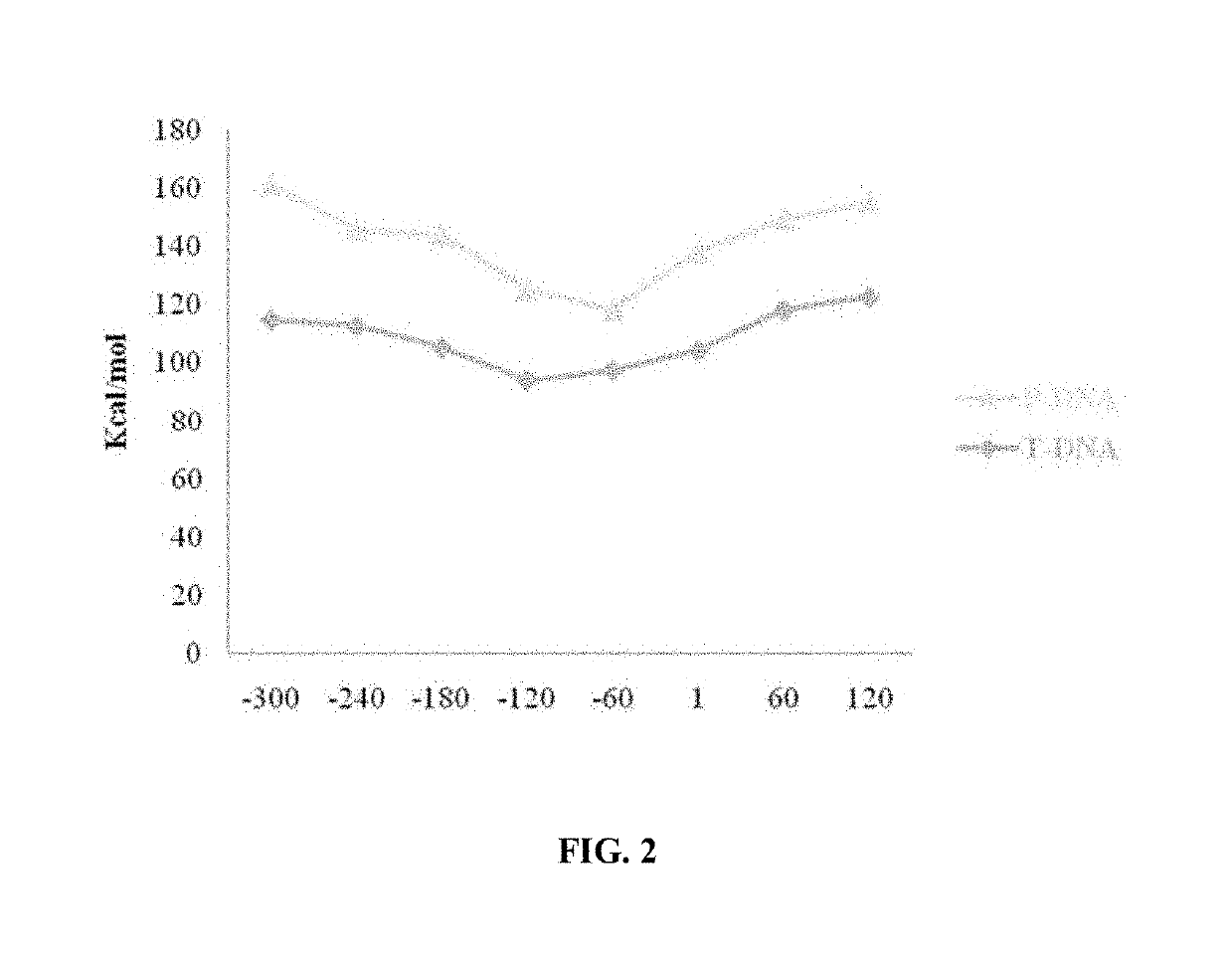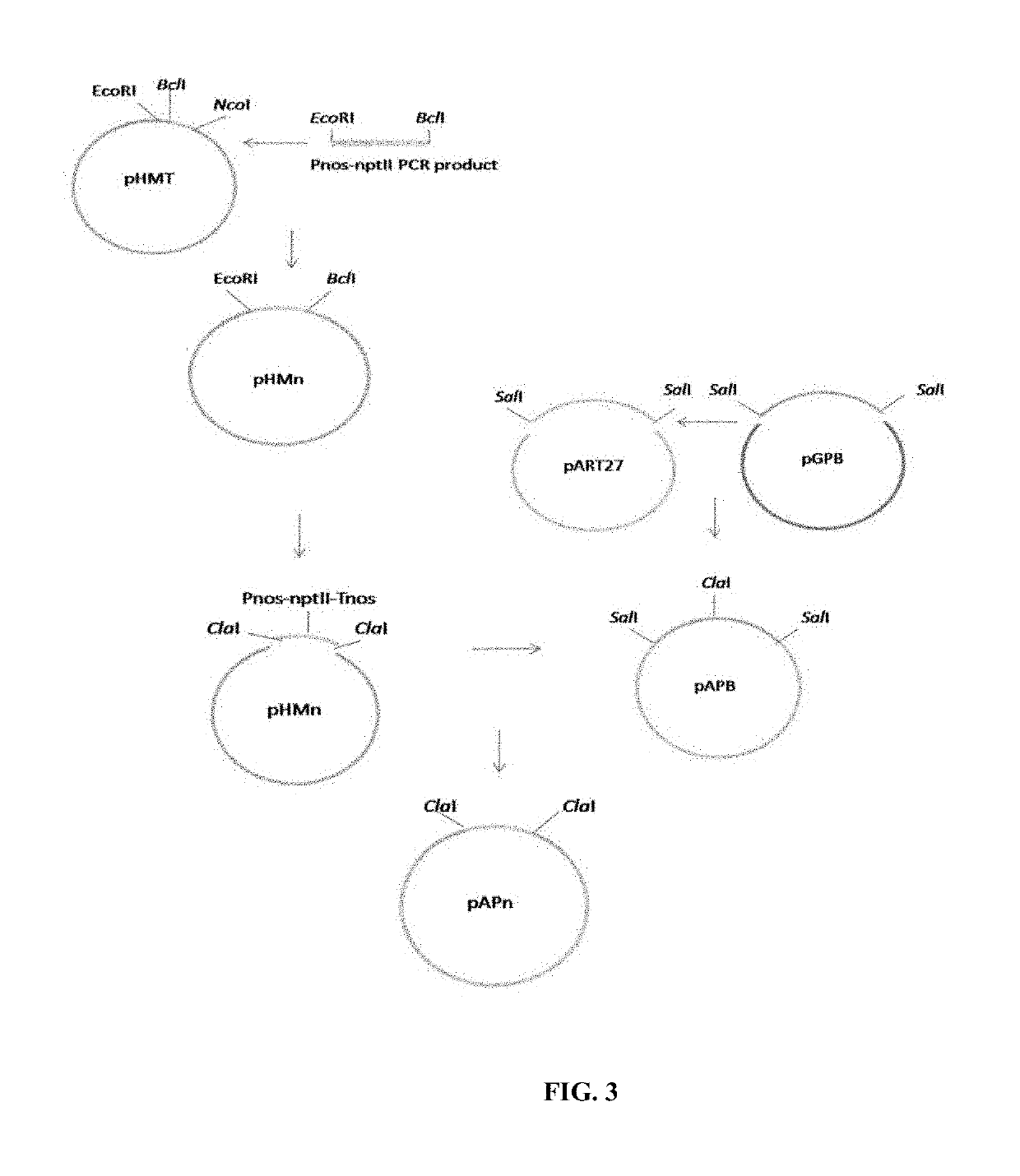Binary vectors with minimized biosafety concerns and high transformation rates by engineered plant-derived transfer-DNA
a technology of plant-derived transfer dna and binary vectors, which is applied in the field of binary vector production, can solve the problems of hammering the preparation of the required documents for their releas
- Summary
- Abstract
- Description
- Claims
- Application Information
AI Technical Summary
Benefits of technology
Problems solved by technology
Method used
Image
Examples
example 1
Construction of pAPn and pAPF2rn Vectors
[0022]FIG. 1 illustrates the cloning strategy for producing pAPB followed by cloning strategy for producing pAPn constructs. A 283-bp and a 155-bp sequences corresponding to RB and LB of P-DNA, respectively, were selected from sugar beet genome deliberately such that only the essential elements for DNA transfer were included. Moreover, it contains a high A / T content (59.4% versus 51.1% for T-DNA), which may affect initiation of the P-DNA transfer, as well. As illustrated in FIG. 3, pAPB vector was constructed in several steps through conducting conventional digestion and ligation reactions. In fact, the synthesized P-DNA substituted a conventional T-DNA between SalI restriction sites of pART27 binary vector, which is a derivative of pTiC58 carrying elements such as RB, LB, ACR and C-clusters. To examine P-DNA functionality, an expression cassette carrying Pnos-nptII-Tnos encoding neomycin phosphotransferase (nptII) was also cloned between the ...
example 2
Increasing Transformation Rate of Tobacco Cells Using pAPn Vector
[0023]Leaf explants of Nicotiana tabacum L. cv Xanthi were transformed with Agrobacterium tumefaciens strain GV3101 carrying pAPn, the newly developed binary vector containing either P-DNA or pART27, as a conventional binary vector containing T-DNA. Overnight-grown bacterial cultures were precipitated for 10 min at 2800 ×g and re-suspended in 50 ml LB medium containing 100 μM acetosyringone to 0.5 OD600. These cultures were used to infect leaf and petiole segments of tobacco for 10 min. The infected segments were incubated for 72 h on co-culture medium (MS medium supplemented with 400 mg lit-1 cefotaxime, 50 mg lit-1 kanamycin and 0.1% agarose plus 1 mg lit-1 BA and 0.1mg lit-1 IBA) at 25° C. in dark. They subsequently transferred to regeneration medium (MS medium supplemented with 1 mg lit-1 BA, 0.1 mg lit-1 IBA, 300 mg lit-1 cefotaxime, 100 mg lit-1 kanamycin and 0.1% agarose). They were sub-cultured in two week inte...
example 3
Producing Sugar Beet Hairy Root Using pAPn Vector
[0026]For hairy root transformation, leaves and petioles of sugar beet variety SBSI-02 were exposed to Agrobacterium rhizogenes strain 15834 carrying either pAPn or pART 27 vectors. Overnight-grown bacterial cultures were precipitated for 10 min at 2800×g before re-suspension in 50 ml LB medium containing 100 μM acetosyringone to OD600 of 0.5. The infected leaf and petiole segments of sugar beet were incubated for 48 h on co-culture medium (MS supplemented with 100 μM acetosyringon) at 25° C. in dark. They were subsequently transferred to rooting medium (MS supplemented with 400 mg lit−1 cefotaxime, 50 mg lit−1 kanamycin and 0.1% agarose) and subcultured every two weeks. After 1 month roots were separated and grown in liquid medium (MS supplemented with 400 mg lit−1 cefotaxime and 50 mg lit−1 kanamycin) while shaking at 100 rpm for two months. Formations of hairy roots were traced by performing a PCR using Pnos-F and nptII-R primer pa...
PUM
| Property | Measurement | Unit |
|---|---|---|
| color | aaaaa | aaaaa |
| stability | aaaaa | aaaaa |
| width | aaaaa | aaaaa |
Abstract
Description
Claims
Application Information
 Login to View More
Login to View More - R&D
- Intellectual Property
- Life Sciences
- Materials
- Tech Scout
- Unparalleled Data Quality
- Higher Quality Content
- 60% Fewer Hallucinations
Browse by: Latest US Patents, China's latest patents, Technical Efficacy Thesaurus, Application Domain, Technology Topic, Popular Technical Reports.
© 2025 PatSnap. All rights reserved.Legal|Privacy policy|Modern Slavery Act Transparency Statement|Sitemap|About US| Contact US: help@patsnap.com



